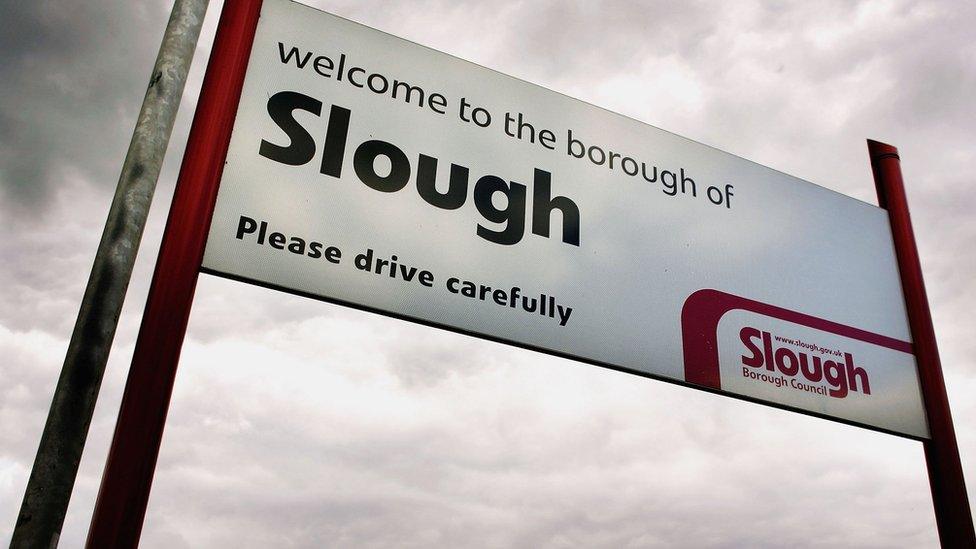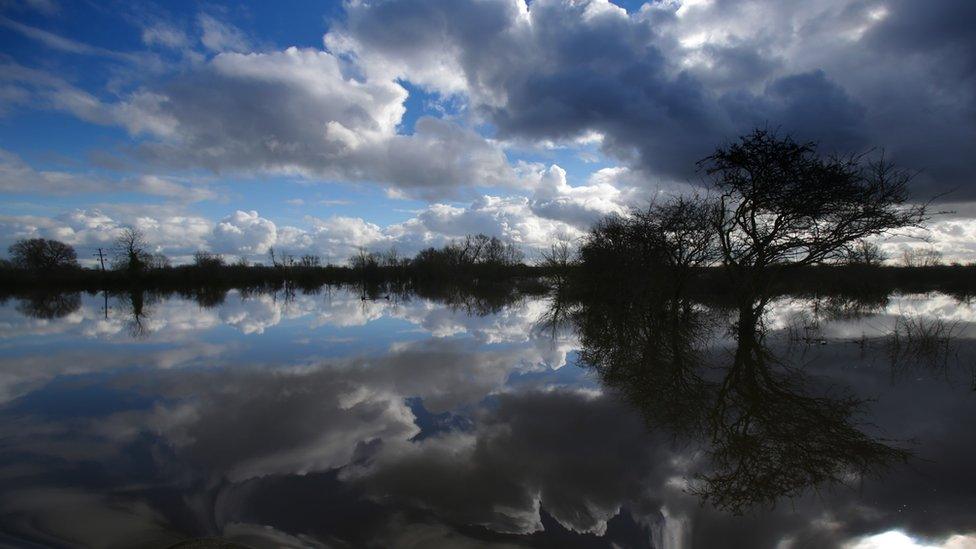'Spongy roads' to be Slough's new claim to fame
- Published
- comments

The Office's fictional paper company Wernham Hogg was located in Slough Trading Estate
Ricky Gervais put its trading estate on the map in The Office, while poet John Betjeman famously invited friendly bombs to fall on Slough.
But now the Berkshire town looks set to gain a new claim to fame as it will get the Chinese "sponge city" treatment.
The flood defence system sees selected roads transformed with permeable surfaces that soak up surface water.
It is one of 25 innovative new environmental projects around England to be backed with government cash.
Pioneered in China - Wuhan, now best known for an entirely different reason, is considered its leading sponge city - the project in Slough sees participating areas turn a proportion of their urban land into sponge features to absorb rain and flood water.
Under the programme, managed by the Environment Agency, the town will also use natural vegetation to improve drainage.
Slough Borough Council said the six-year project would use plants and trees to absorb water "to such an extent it will minimise the risk to homes and businesses of flooding".
It added: "They act as sponges, soaking up surface water, creating an environment where water can be captured, controlled and in some cases re-used."
The sponge city approach will be implemented at multiple sites along Salt Hill Street and Chalvey Ditches, the authority said.

Analysis
Roger Harrabin, BBC environment analyst
What's new about the sponge city story is not the concept, but the title.
For years, local councils have been encouraged to make city surfaces porous whenever they can.
Neath in South Wales has installed clever landscape tricks such as detention basins, retention ponds, soakaways, and swales.
They have a great scheme to turn a school playing field into a lake during heavy rain and they have dug a pond system which teaches kids about frogs as well as floods.
But this all sounds a bit nerdy, and funding has been short for what are known as SuDS - Sustainable Drainage Systems.
Where front gardens are paved over, for instance, they are supposed to be engineered so they allow water to seep back into the ground, rather than rushing into the sewers.
But in most places there is little cash for enforcement and tradespeople carry on as before.
Perhaps the new title of sponge city will help common sense to prevail.
Follow Roger on Twitter @rharrabin , external

A further 24 schemes aimed at improving waterway defences and coastal resilience will also get a share of £150m as part of the government's new flood and coastal resilience innovation programme, external.

Slough, which has always been ahead of the curve, is also the place that invented the wheelie bin
They include the restoration of sub-tidal habitats like kelp beds, oyster reefs and sea grass near South Tyneside.
Residents in Buckinghamshire will get an app to warn them about the threat of groundwater.
And in Northumberland artificial intelligence and new sensor technology will be used to detect rising water levels.
Environment minister Rebecca Pow said the 25 projects will help shape future approaches in preparing communities for flooding and coastal change.
It will also help "reinforce the UK's position as a world leader in innovation and new technology as we build back better," she added.
Emma Howard Boyd, chairwoman of the Environment Agency, called the project "extremely exciting" and said it could be replicated on a larger scale around the world if successful.
Here is the full list of local areas involved in 25 specialised projects:
Grimsby, Immingham and Doncaster
Areas nearby the River Swale, Ure, Nidd and Ouse catchments
Northumberland
South Tyneside coastline
Stockton-on-Tees
County Durham
Gateshead
Cumbria
Rochdale
Wyre
Northamptonshire
Lincolnshire
Staffordshire
Thurrock and Southend-on-Sea
Suffolk and Norfolk
Central Bedfordshire
Chilterns and Berkshire Downs
Slough
Eastbourne
The London boroughs of Barnet, Harrow and Brent
Richmond-upon-Thames
Cornwall
Devon
City of Bristol
Related topics
- Published14 September 2018

- Published22 September 2017

- Published26 April 2017

- Published10 January 2014

- Published29 July 2013
